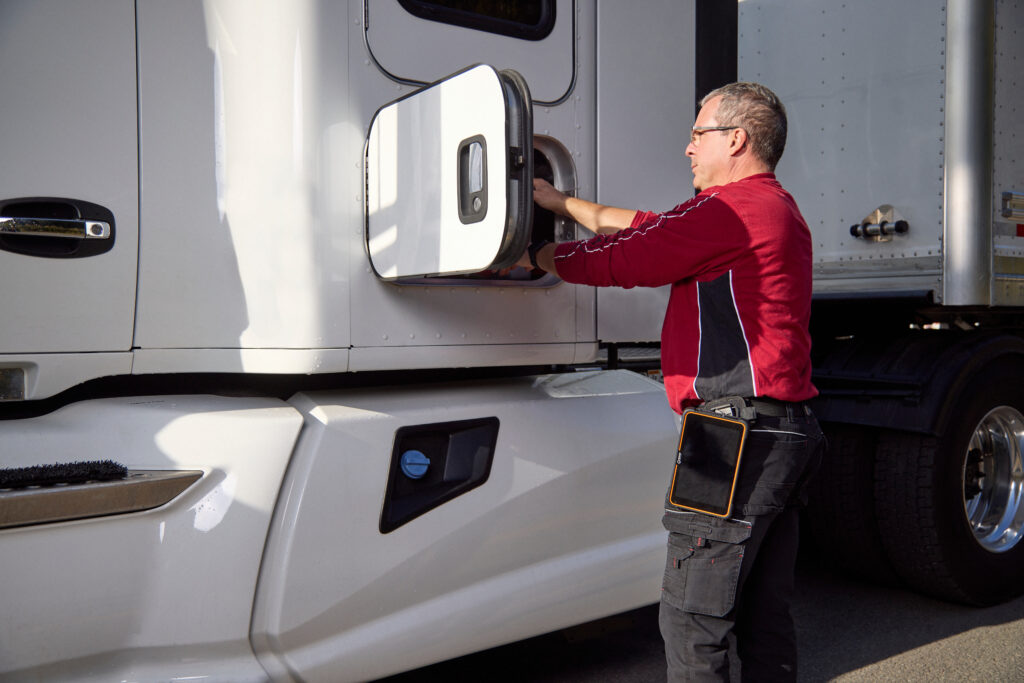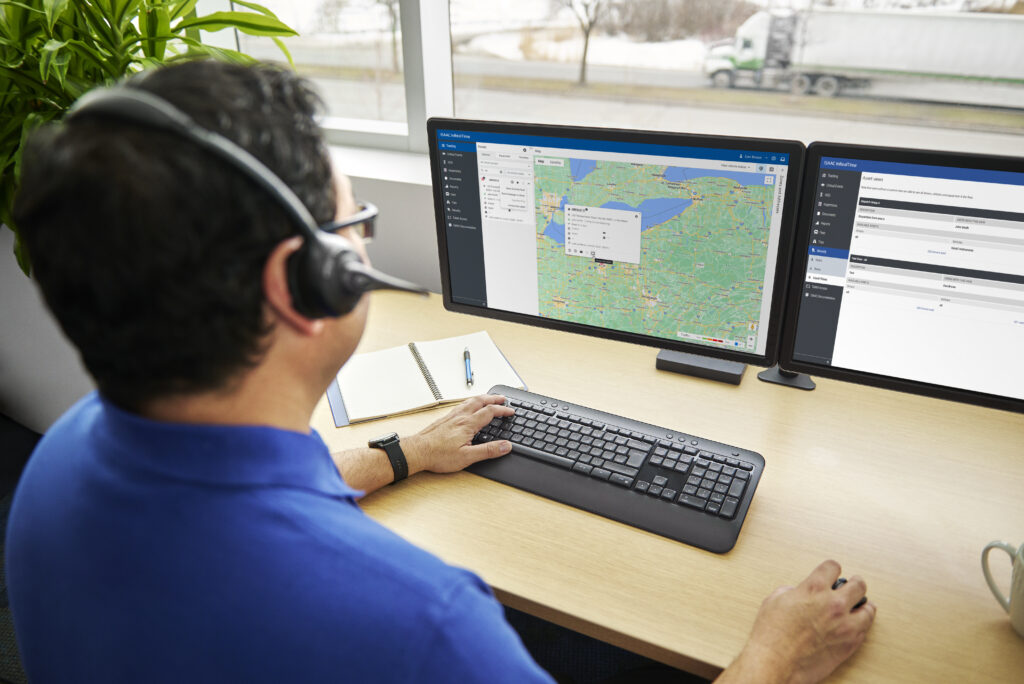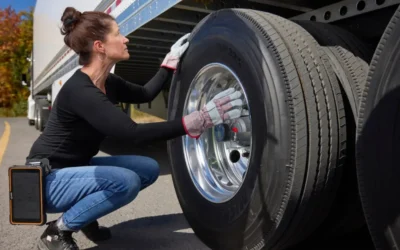A shift in driver monitoring
The best way to improve truck driver behavior is through ongoing training and monitoring. While ELDs were developed to track compliance with hours of service (HOS) regulations, today’s sophisticated ELD technology, coupled with telematics, can be much more than just a replacement for the paper logbooks of old. By integrating the data generated by in-cab technology into an intelligent feedback loop, it’s possible to identify trends in risky driving behaviors and proactively intervene before any safety problems arise. But that’s just the beginning of how the right fleet management solution can benefit drivers and trucking fleets.
Call 1-800…drive better
Roughly 20 years ago, signs began appearing on the back of trailers with the question, “How’s my driving?” and a toll-free number to call. Clearly, these were attempts to recruit motorists to help monitor driver behavior. Just as clearly, this approach had several problems, including:
- A likelihood that only negative feedback would ever be shared by callers
- Built-in bias, given that average motorists know very little about a tractor-trailer’s operational reality, such as typical braking distance and turning radius.
- The inability to verify the accuracy of any reported incident
- Understandable lack of buy-in from the drivers themselves
While this telephone reporting idea left a lot to be desired, there is a still strong case for some sort of monitoring of how your drivers operate on North American roadways. Better designed, more thorough and fair monitoring can take center stage in any truck driver safety program. After all, your fleet’s reputation rides on the performance and professionalism of each of your drivers.
The key to successfully monitoring driver behavior is to have a system that is effective, and fair—and above all—constructive for the driver. This approach is far more effective than sin gling out anyone for criticism and disciplinary action. This is where technology can be transformative.

Telematics and the Internet of Trucks
Everyone has heard of the Internet of Things (IoT) and Big Data. Broadband internet connectivity virtually everywhere, together with widely available, small, and inexpensive sensors, has made both IoT and Big Data easily available to businesses of any size.
When sensors and connectivity are part of advanced in-cab technology, a whole new world opens up in trucking. ELDs can go beyond simply recording hours of service. You now have access to powerful tools that enable IoT for trucking—an Internet of Trucks, if you will. This type of technology solution can provide:
- Ongoing, real-world training tailored to every driver, no matter their experience level
- Continuous connections and communication between each driver and the back office
- Data-driven monitoring with sensors such as accelerometers, speed gauges, etc.
- The generation of a large amount of data that can inform AI algorithms to identify trends and make predictions
The best way to influence driver behavior and reinforce the practices for safety and eco-driving is to use real-time monitoring and feedback, and provide coaching to limit less-than-ideal behaviors. By making use of the Big Data that a modern ELD and other in-cab technology will generate, you can identify any negative trends in performance. You can also take note of desirable trends and use positive reinforcement to encourage driving styles that are good from both a fuel-saving and eco-driving perspective, as well as a safety perspective.
This technology can also go beyond simply monitoring the driver’s actions. It can also track external factors that can influence driver behavior, such as headwinds or slopes , as well as mechanical conditions (think brake wear or low tire pressure). Catching mechanical issues before they cause excessive fuel consumption or unsafe conditions is to everyone’s benefit.
The ISAAC Coach is designed to provide real-time feedback to promote eco-driving, monitoring practices such as speeding, braking and acceleration, and abrupt maneuvers. It factors out things over which drivers have absolutely no control, such as road inclines and declines. The results in fuel economy alone—typically a 5% savings across the fleet—can more than cover the systems’ cost. The additional benefits that this training and coaching of driving behavior can have on safety are also important.
Calculate Potential Fuel Savings
Can data and AI aid driver retention?
ISAAC’s solution generates large amounts of data, and we are continually working to innovate new ways to leverage this to benefit our clients. Applying data analytics to extract and transform the data and then using Artificial Intelligence algorithms to gain predictive insights is an avenue we are vigorously exploring.
We recently co-hosted a webinar with FreightWaves on how using data analytics & AI can simplify fleet operations. Watch this webinar to hear firsthand how Tandet Group is starting to leverage AI to make informed decisions. By using the technology to spot trends and predict issues before they arise, Tandet is increasing safety and improving efficiencies across the fleet.
Accentuate the positive
According to a World War II-era song by Bing Crosby, “You’ve got to AC-CENT-U-ATE the positive.” Eighty years later, this remains good advice—especially when it’s applied to changing driver behavior.
It’s a simple fact that, in any sort of education or training, positive reinforcement (such as praise for an action) is far more effective than negative reinforcement. It is also central to getting buy-in from both your drivers and back-office staff. Among drivers, no one likes to think that a system is in place to catch them doing something wrong and report them to fleet managers. For starters, that creates an assumption that good actions (consistently safe and responsible driving behavior) will go largely unnoticed, while any slip-ups will immediately be singled out.
Among the back-office staff or fleet managers, people rarely enjoy confronting a driver to point out problems and take corrective action. Besides dreading having to give negative feedback, even if it’s constructive criticism, it also can cause them to worry the driver will get angry and quit. When you factor in that a driver shortage continues to be a problem, it can put undue stress on the person who has “lost” more than one driver after delivering some feedback.

By coaching drivers to be more efficient and safer through praising positive driving behaviors, carriers can reduce fuel costs, improve safety, and minimize the risk of accidents. In addition, they can single out examples of positive driving behaviors and proper responses during tricky situations when training other drivers. This creates an overall atmosphere where drivers will feel good about the training. The driver being used as a positive example for others will probably feel some pride, and drivers seeing this in training will probably expect positive reinforcement rather than criticism as they go about their work.
In short, positive reinforcement can go a long way towards fostering a culture of safe driving practices as well as eco-driving. Offering incentives for achieving safety goals or staying within established parameters can help motivate drivers to drive responsibly.
The right tools make any job easier
While there is a difference between eco-driving aimed at fuel savings and overall sustainability, and driving behaviors geared towards safety and avoiding accidents, there is an overlap between the two. Technology plays a vital role in both. Specifically, the right in-cab technology can offer the ability to monitor driving behavior in real time and provide ongoing training and coaching that reflects well on the drivers and the fleet as a whole.
As part of ISAAC’s in-cab solution, the ISAAC Coach is specifically designed to provide the tools to encourage the best driving habits. It also allows two-way communication and remote connection from the back office to individual trucks. Having the ability to connect remotely onto any vehicle tablet in your fleet, to see exactly what the driver views and to provide immediate help is a blessing for everyone. It allows for instant coaching opportunities that foster a positive environment that makes for happier drivers and safer, more efficient fleets.
To learn more about how this technology can put your fleet on the best possible path, read our white paper Technology Improves Driver Training.










